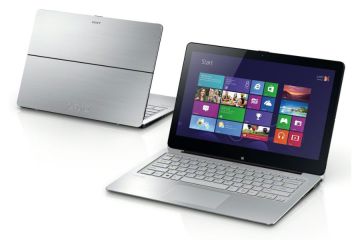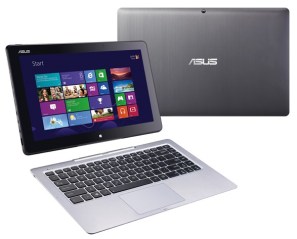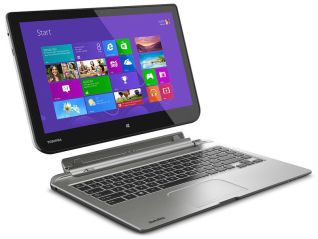Nearly a year after Windows 8’s debut, it’s still hard to find hardware that makes a great match for Microsoft’s dual-headed operating system.
But that may soon change. At the IFA trade show this week, several PC vendors announced new Windows 8 hybrids that can transform from a laptop into a tablet. Some of them look like major improvements over the first wave of hybrids that launched alongside Windows 8 last winter.
What’s taken so long? Partly, it’s a matter of processing power, as new chips from Intel and AMD promise better battery life, zippier performance and higher screen resolutions. Hardware makers have also learned some lessons over the last year, and have refined their hybrid designs to be thinner, lighter and more clever.
Let’s take a look at the new hybrids that Windows PC makers plan to offer later this year:
The Convertibles
I used to think that all Windows 8 hybrids should be detachable, allowing users to pull the screen apart from the keyboard to use it like a tablet. Lately, though, I’ve come to appreciate hybrids with permanently attached keyboards. Because the guts of these machines can still reside under the keyboard, they can pack more power without being top-heavy or sacrificing battery life. The laptop experience isn’t compromised, and tablet usage is an added bonus. It’s great to see PC makers working on more refined approaches to the Windows 8 convertible.
Lenovo’s Yoga 2 Pro (pictured above), for instance, is thinner than the original 13-inch Yoga, at 0.59 inches, and it’s a lot lighter at 3.06 pounds. Its 3200-by-1800 resolution display packs four times the pixels of the first Yoga, and Lenovo will offer up to 8 GB of RAM and up to an Intel Core i7 processor. To switch between laptop and tablet modes, the Yoga has a 360-degree hinge for tilting the screen all the way back underneath the body. It’s shipping next month for $1,099 and up.

The one thing that worries me with the Yoga is battery life. While Lenovo proudly trumpets nine hours on a charge, the footnotes of its press release clarify that this runtime is “achieved with Windows 8 idle at 150 nits.” In other words, you’ll have to be doing nothing, at less than 50 percent brightness to hit the nine-hour mark. With video playback at the same brightness, Lenovo is promising just six hours, which doesn’t sound like much of an improvement over the first Yoga. I wonder if Lenovo has made a huge mistake by pushing screen resolution so high, thereby squandering the power efficiency that comes with Intel’s new Haswell processors.
Lenovo’s also bringing out a business-friendly version, dubbed the ThinkPad Yoga, with a more rugged design and the classic red cursor nub found on other ThinkPads. It’s thicker and heavier than the Yoga 2, at 0.74 inches and 3.48 pounds, but it has a neat trick: When you fold it into tablet mode, the area behind the keyboard rises up, and the keys lock into place, forming somewhat of a flat surface. Lenovo’s offering a hard drive option for the ThinkPad Yoga, up to 1 TB, or a solid state drive up to 256 GB. The battery will last “up to 7 hours,” according to Lenovo. Pricing’s going to start at $949, with November availability.

Meanwhile, Sony has its own take on the convertible laptop with the Vaio Flip. The screen isn’t attached directly to the base, but instead rests on a short flap via a hinge. This allows the screen to rotate around and fold down into tablet mode. The only downsides are that the flap prevents the screen from sitting flush in tablet mode, and that you need to manually unlock the hinge to flip the screen around.
The specs sound good, though, with a choice of 13-inch, 14-inch or 15-inch screens at 1080p resolution. Storage starts at 128 GB, and performance maxes out with Intel Core i7 processors and 12 GB of RAM. While the 13-inch version will be the most tablet-like, weighing just 2.6 pounds, the 14- and 15-inch models can get a dedicated graphics card, and the largest model can get a 2880-by-1620 resolution display. No word on price or release date, though.
The Detachables
Technology still presents some challenges for detachable hybrids, especially those with Intel’s Core processors. All the computing parts must live behind the screen, and big batteries are needed, so you end up with top-heavy devices that are often thicker and heavier than conventional laptops.
Sony’s Vaio Tap 11 sounds the most promising. It’s a standalone 11-inch tablet that measures a reasonable 0.39 inches thick, and while the Bluetooth keyboard and trackpad dock doesn’t attach during use, it uses magnets to hold itself against the screen during travel. A digitizer pen comes standard as well. Processor options include Intel Pentium or Core processors, and there’s a 128 GB solid state drive on board, but the promised six-hour battery isn’t stellar. Pricing and release date remain mysteries for now.

If you must keep your keyboard and tablet attached during use, Asus’ Transformer Book T300 could be what you’re after. It has a 13-inch 1080p display, up to an Intel Core i7 processor, up to 8 GB of RAM and up to 256 GB of storage. Battery life doesn’t sound too bad, at 8 hours, but apparently the docking station doesn’t provide any additional charge. Even so, the whole package measures 0.89 inches thick and weighs 4.1 pounds, which is pretty beastly for a 13-inch laptop by today’s standards. No word on pricing.
Toshiba’s Click is another option, but it’s a funky one for a couple of reasons: It comes with a 500 GB hard drive instead of solid state storage, and it uses AMD’s A4 processor with Radeon 8000 graphics. This allows for a fanless design and decent graphics performance, but battery life doesn’t sound so hot, with Engadget reporting just three to four hours for the tablet and six or seven hours for the whole combo.

I suspect we’ll see more detachables with Intel’s low-power Bay Trail processors later this year. They won’t be as capable as these machines, but they should be much thinner and lighter, with longer battery life, making them a better fit for this type of hybrid.
As for when we’ll see all these new hybrids, any time on or after October 18 is likely. That’s the date of the retail launch for Windows 8.1, an upgrade with some big improvements on both the Metro and desktop sides of the operating system. Along with the better hardware, I’m hoping this will be a good time to get on board.

